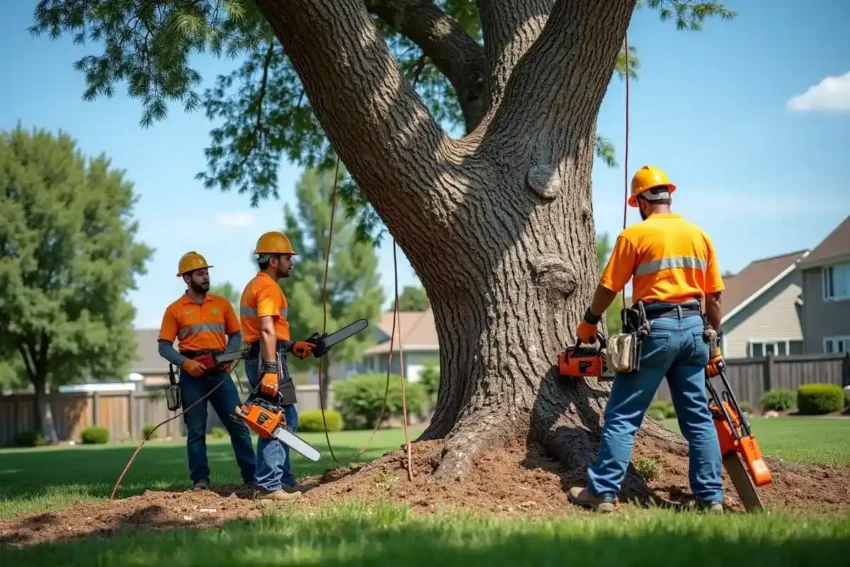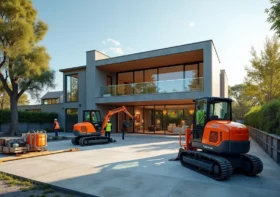Property Tree Removal: Risks, Rules, and Considerations

Trees add beauty and value to properties, but sometimes removal becomes necessary. Safety hazards, structural risks, and legal requirements can all influence the decision. Knowing what to expect before arranging removal helps homeowners make informed choices and avoid costly mistakes.
Contents
Understanding Safety Risks
Tree removal often comes down to safety concerns. Large trees close to homes can threaten roofs, windows, and foundations during storms. Weak or diseased branches may fall unexpectedly and injure people or damage vehicles. Roots can disrupt underground pipes, driveways, or sidewalks. Evaluating these risks ensures that problems are addressed before accidents occur.
A professional assessment highlights whether pruning can solve the issue or if full removal is the better option. Homeowners should remember that neglecting visible warning signs increases the likelihood of serious incidents.
Removing hazards before they escalate can prevent emergencies that demand costly repairs. By planning removal at the right time, homeowners preserve both property value and personal safety. Ignoring risks places unnecessary pressure on family members and can create long-term structural damage that far exceeds the price of preventive work. A cautious review of potential threats helps guide the best course of action for each unique property.
Legal Rules and Regulations
Removing trees is not always a straightforward decision. Many councils have strict rules protecting trees, especially mature or native species. Fines can apply when property owners ignore these laws. Some areas require permits for trees above a certain height or girth, while others protect species considered environmentally valuable.
Understanding local regulations avoids delays and penalties. Homeowners should check requirements early, as approvals may take weeks and often involve site inspections. Consulting local planning authorities prevents setbacks during the removal process.
Working within the rules builds good relationships with neighbors and ensures compliance. Rather than risking enforcement actions, property owners benefit by knowing their responsibilities ahead of time. Being informed also provides peace of mind, since the process proceeds legally and without unexpected complications. Clarity in these matters saves both time and resources, while encouraging responsible management of shared green spaces.
Role of Professional Arborists
Specialists provide guidance that homeowners cannot gain on their own. Qualified tree removal experts inspect the health, stability, and placement of trees. As explained by Shane’s Trees arborists, they use professional equipment to safely cut, trim, or remove large structures that would be dangerous for untrained individuals.
Work is carried out following industry standards to protect both property and surrounding vegetation. Many homeowners rely on expert advice, since their experience helps determine safe methods for handling even the most complex removals.
Hiring professionals reduces the likelihood of damage to property, ensures safe working conditions, and provides reliable outcomes. Their knowledge helps balance removal with preservation when possible. In many cases, expert recommendations lead to alternative solutions such as pruning or cabling, which can extend a tree’s life while still reducing risks. The value of this expertise lies in offering options that homeowners might not have considered on their own. For these reasons, engaging with tree removal services sydney or elsewhere ensures that trained professionals handle these tasks safely, efficiently, and in accordance with industry standards, providing both peace of mind and optimal results.
Environmental Considerations
Tree removal has environmental impacts that deserve attention. Trees absorb carbon dioxide, provide shade, and offer shelter for wildlife. Eliminating them changes the microclimate of the property and can affect soil health. Responsible arborists recommend replanting suitable replacements to maintain ecological balance. They may also suggest retaining part of the tree as habitat, such as hollow trunks that benefit local bird species.
Homeowners should weigh short-term benefits against long-term ecological changes. By choosing replanting and responsible disposal methods, they can reduce the impact of necessary removals. An environmentally conscious approach not only protects wildlife but also supports property value by maintaining an attractive and balanced landscape.
Financial Implications of Removal
Costs vary depending on size, location, and complexity of the work. A small tree in an open yard may cost little, while a large tree leaning toward a building requires special equipment and higher fees. Additional expenses may arise if stump grinding, root removal, or site restoration is necessary. While some homeowners hesitate due to cost, delaying removal often increases expenses. Damages caused by falling branches or roots typically exceed the price of professional services, making timely action a practical choice.
Evaluating costs ahead of time allows homeowners to budget effectively. Professional services provide clear estimates and explain options, helping families avoid financial surprises later. Investing in safe removal may seem expensive at first glance, but the long-term savings in avoided damage and preserved safety make it a wise financial decision.
Preparing for the Process
Before work begins, preparation ensures a smoother experience. Homeowners should clear access paths for workers and move vehicles or outdoor furniture away from the site. Notifying neighbors is courteous, especially if equipment or debris may affect shared areas.
Planning for disposal is important, whether through firewood, mulch, or removal by professionals. By setting expectations and preparing the site, homeowners reduce disruption and help the process finish quickly and safely. Coordinating with the crew avoids delays and ensures efficiency.
Clear communication with arborists about timing, scope, and cleanup guarantees that the project runs efficiently. Proper preparation helps reduce stress and creates a better overall outcome. Families who take time to organize before removal begins often find that the process feels less disruptive and more manageable.
The decision to remove a tree should never be taken lightly, but careful evaluation of safety, regulations, environmental impact, and financial planning makes it manageable. By working with professionals and preparing properly, homeowners can approach tree removal with confidence and peace of mind.



